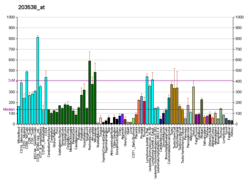Calcium modulating ligand (CAMLG or CAML), also known as calcium-modulating cyclophilin ligand, is a signalling protein recognized by the TNF receptor TACI.[5][6]
Function
The immunosuppressant drug cyclosporin A blocks a calcium-dependent signal from the T-cell receptor (TCR) that normally leads to T-cell activation. When bound to cyclophilin B, cyclosporin A binds and inactivates the key signaling intermediate calcineurin. The protein encoded by this gene functions similarly to cyclosporin A, binding to cyclophilin B and acting downstream of the TCR and upstream of calcineurin by causing an influx of calcium. This integral membrane protein appears to be a new participant in the calcium signal transduction pathway, implicating cyclophilin B in calcium signaling, even in the absence of cyclosporin.[6]
References
- 1 2 3 GRCh38: Ensembl release 89: ENSG00000164615 - Ensembl, May 2017
- 1 2 3 GRCm38: Ensembl release 89: ENSMUSG00000021501 - Ensembl, May 2017
- ↑ "Human PubMed Reference:".
- ↑ "Mouse PubMed Reference:".
- ↑ Bram RJ, Valentine V, Shapiro DN, Jenkins NA, Gilbert DJ, Copeland NG (March 1997). "The gene for calcium-modulating cyclophilin ligand (CAMLG) is located on human chromosome 5q23 and a syntenic region of mouse chromosome 13". Genomics. 31 (2): 257–60. doi:10.1006/geno.1996.0044. PMID 8824814.
- 1 2 "Entrez Gene: CAMLG calcium modulating ligand".
- ↑ von Bülow GU, Bram RJ (October 1997). "NF-AT activation induced by a CAML-interacting member of the tumor necrosis factor receptor superfamily". Science. 278 (5335): 138–41. doi:10.1126/science.278.5335.138. PMID 9311921.
- ↑ Xia XZ, Treanor J, Senaldi G, Khare SD, Boone T, Kelley M, Theill LE, Colombero A, Solovyev I, Lee F, McCabe S, Elliott R, Miner K, Hawkins N, Guo J, Stolina M, Yu G, Wang J, Delaney J, Meng SY, Boyle WJ, Hsu H (July 2000). "TACI is a TRAF-interacting receptor for TALL-1, a tumor necrosis factor family member involved in B cell regulation". J. Exp. Med. 192 (1): 137–43. doi:10.1084/jem.192.1.137. PMC 1887716. PMID 10880535.
Further reading
- Bram RJ, Crabtree GR (1994). "Calcium signalling in T cells stimulated by a cyclophilin B-binding protein". Nature. 371 (6495): 355–8. doi:10.1038/371355a0. PMID 7522304.
- von Bülow GU, Bram RJ (1997). "NF-AT activation induced by a CAML-interacting member of the tumor necrosis factor receptor superfamily". Science. 278 (5335): 138–41. doi:10.1126/science.278.5335.138. PMID 9311921.
- Holloway MP, Bram RJ (1998). "Co-localization of calcium-modulating cyclophilin ligand with intracellular calcium pools". J. Biol. Chem. 273 (26): 16346–50. doi:10.1074/jbc.273.26.16346. PMID 9632697.
- Tovey SC, Bootman MD, Lipp P, Berridge MJ, Bram RJ (2000). "Calcium-modulating cyclophilin ligand desensitizes hormone-evoked calcium release". Biochem. Biophys. Res. Commun. 276 (1): 97–100. doi:10.1006/bbrc.2000.3442. PMID 11006089.
- Larramendy ML, Niini T, Elonen E, Nagy B, Ollila J, Vihinen M, Knuutila S (2003). "Overexpression of translocation-associated fusion genes of FGFRI, MYC, NPMI, and DEK, but absence of the translocations in acute myeloid leukemia. A microarray analysis". Haematologica. 87 (6): 569–77. PMID 12031912.
- Feng P, Park J, Lee BS, Lee SH, Bram RJ, Jung JU (2002). "Kaposi's sarcoma-associated herpesvirus mitochondrial K7 protein targets a cellular calcium-modulating cyclophilin ligand to modulate intracellular calcium concentration and inhibit apoptosis". J. Virol. 76 (22): 11491–504. doi:10.1128/JVI.76.22.11491-11504.2002. PMC 136794. PMID 12388711.
- Tran DD, Russell HR, Sutor SL, van Deursen J, Bram RJ (2003). "CAML is required for efficient EGF receptor recycling". Dev. Cell. 5 (2): 245–56. doi:10.1016/S1534-5807(03)00207-7. PMID 12919676.
- Kumar R, Lutz W, Frank E, Im HJ (2004). "Immediate early gene X-1 interacts with proteins that modulate apoptosis". Biochem. Biophys. Res. Commun. 323 (4): 1293–8. doi:10.1016/j.bbrc.2004.09.006. PMC 2895269. PMID 15451437.
- Guo S, Lopez-Ilasaca M, Dzau VJ (2005). "Identification of calcium-modulating cyclophilin ligand (CAML) as transducer of angiotensin II-mediated nuclear factor of activated T cells (NFAT) activation". J. Biol. Chem. 280 (13): 12536–41. doi:10.1074/jbc.M500296200. PMID 15668245.
- Nagano J, Kitamura K, Hujer KM, Ward CJ, Bram RJ, Hopfer U, Tomita K, Huang C, Miller RT (2006). "Fibrocystin interacts with CAML, a protein involved in Ca2+ signaling". Biochem. Biophys. Res. Commun. 338 (2): 880–9. doi:10.1016/j.bbrc.2005.10.022. PMID 16243292.
|
|---|
| Chemokine | |
|---|
| CSF | |
|---|
| Interferon | | IFNAR (α/β, I) |
- Agonists: Albinterferon
- Interferon alpha (interferon alfa, IFN-α)
- Interferon alfa (IFNA1, IFNA2, IFNA4, IFNA5, IFNA6, IFNA7, IFNA8, IFNA10, IFNA13, IFNA14, IFNA16, IFNA17, IFNA21)
- Interferon alfa 2a
- Interferon alfa 2b
- Interferon alfa n1
- Interferon alfacon-1
- Interferon alpha-n3
- Interferon beta (IFN-β) (IFNB1, IFNB3)
- Interferon beta 1a
- Interferon beta 1b
- Interferon kappa (IFN-ε/κ/τ/ζ, IFNK)
- Interferon omega (IFN-ω, IFNW1)
- Peginterferon alfa-2a
- Peginterferon alfa-2b
- Decoy receptors: Bifarcept
|
|---|
| IFNGR (γ, II) | |
|---|
| IFNLR (λ, III) |
- See IL-28R (IFNLR) here instead.
|
|---|
|
|---|
| Interleukin | |
|---|
| TGFβ | |
|---|
| TNF | |
|---|
| Others | |
|---|
- See also
- Receptor/signaling modulators
- Signaling peptide/protein receptor modulators
- Growth factor receptor modulators
|




